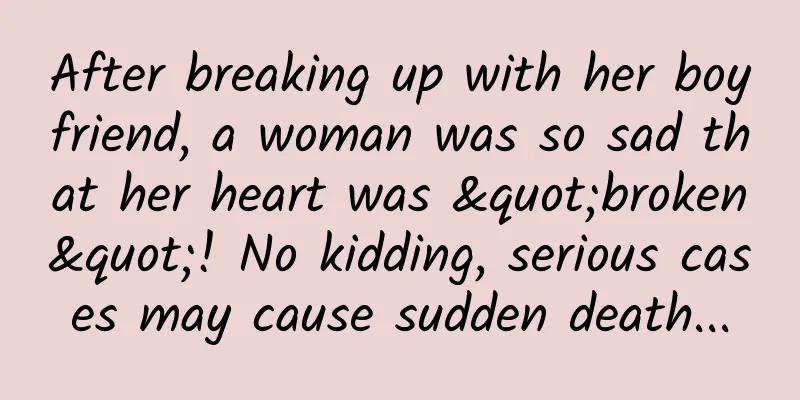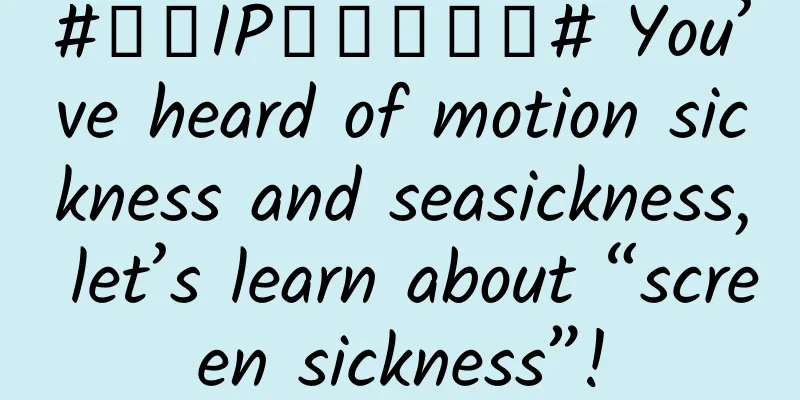After breaking up with her boyfriend, a woman was so sad that her heart was "broken"! No kidding, serious cases may cause sudden death...

|
Expert in this article: Yang Chao, MD, attending physician at the Rocket Force Special Medical Center Reviewer of this article: Chen Haixu, Deputy Director and Master Supervisor of the Second Medical Center of PLA General Hospital "It's so sad, my heart is broken..." Many people often say this when they encounter sad things, often because they feel sad and depressed because of something. But have you ever thought that when you are sad to a certain extent, you may really be "heartbroken". Recently, a woman was very sad after breaking up with her boyfriend. Unexpectedly, she developed chest pain, shortness of breath and other symptoms. After seeing a doctor, the doctor said that the woman's condition was called "broken heart syndrome." Weibo screenshot What is Broken Heart Syndrome? Is the heart really broken? Read on. What is Broken Heart Syndrome? In real life, emotions not only affect people's thinking, but also affect our heart structure. When exposed to great stress such as car accidents, shock, excessive sadness, fear and physical illness, the left ventricle will experience transient segmental myocardial contraction disorders, which we call "broken heart syndrome", also known as stress cardiomyopathy, apical balloon syndrome, Takotsubo syndrome, and octopus pot cardiomyopathy. It was first proposed by Japanese scholar Sato in 1990. Broken heart syndrome is an acute syndrome characterized by transient localized left ventricular systolic dysfunction caused by physical or psychological stress. 17.4 people out of every 100,000 suffer from broken heart syndrome, which is more common in postmenopausal women. The average incidence rate in women is 7.5 times that in men. What are the symptoms of Broken Heart Syndrome? The hearts of patients with broken heart syndrome usually do not have obvious organic lesions such as vascular obstruction, so their hearts are not really "broken", but their signs and symptoms are often similar to those of a heart attack. Doctors generally make a diagnosis through personal medical history and physical examination, electrocardiogram (ECG), echocardiogram, blood myocardial enzyme testing, cardiac magnetic resonance imaging (MRI), coronary angiography and other examinations. Copyright image, no permission to reprint The initial symptoms of broken heart syndrome are similar to those of acute coronary syndrome, generally manifested as severe pain behind the sternum, pressure in the chest area, palpitations, syncope, etc. The symptoms will disappear in most patients within a few weeks. Severe patients may experience pulmonary edema, arrhythmia, or even cardiogenic shock, such as hypotension, cold limbs, dyspnea, and electrocardiogram ST segment changes, but there is no angiographic evidence of obstructive coronary artery disease, and coronary stent placement or surgical bypass surgery is not required. A small number of patients may experience cardiac arrest, respiratory arrest, and sudden death. A study in the Journal of the American Heart Association showed that "broken heart syndrome" not only damages the heart, but may also cause cancer. What factors may trigger broken heart syndrome? ● Emotional stressors: death or injury of relatives or friends, violent quarrels, property loss, legal proceedings, car accidents, etc. ● Physical stressors: severe illness, surgery, severe pain, recovery from general anesthesia, hyperthyroidism, cocaine abuse, etc. Copyright image, no permission to reprint How is Broken Heart Syndrome Treated? There is currently no unified standard treatment for stress cardiomyopathy. The symptoms of broken heart syndrome are similar to those of acute coronary syndrome. Before a clear diagnosis is made, it can be treated according to the treatment of acute coronary syndrome. After the diagnosis is confirmed, the inducing factors should be removed and stress factors should be avoided. The underlying disease should be actively treated and symptomatic supportive treatment should be given. Most patients have a good prognosis and recover within a few days to a few weeks. A few can last for more than 3 months. The in-hospital mortality rate is less than 8%. When we encounter sad things Learn to self-coach Or seek help from others Beware of Broken Heart Syndrome If you experience any discomfort Seek medical attention promptly The cover of this article and the pictures with watermarks in the text are from the copyright library and are not authorized for reproduction |
<<: "Lu Xun withdraws from Chinese textbooks"?
>>: The Earth's "two-faced" inner core rotates faster than the surface
Recommend
A collection of top-notch front-end special effects resources#001
1. Front-end tree diagram -- zTree -- jQuery tree...
Didi Chuxing is banned: The dilemma of the government not doing social innovation
Not long after Didi Chuxing was launched in Augus...
Geely Star is willing to invade BYD's heartland. Can the high-end version beat BYD Dolphin?
On October 9, Geely Xingyuan was officially launc...
Is it expensive to customize the Changji liquor app? Changji wine and beverage applet customization cost and process
There are two types of customization of Changji L...
In addition to selling traffic, there are many other ways to monetize new media.
Last Friday, the fashion giant "Rebecca'...
With no money and no resources, how did Keep gain 60 million users through “dirty work”?
As a post-90s campus entrepreneur with no resourc...
Zhang Pu's "Alibaba's Way to Success: 19 Lectures on Entrepreneurship and Growth"
Zhang Pu's "Alibaba's Way to Success...
Qingming Outing Season | Want to go outing and learn knowledge during the Qingming holiday? Why not go see the "Kidney of the Earth"?
Audit expert: Yang Yanhui Senior Landscape Engine...
Apple iOS 15 officially released: new notification interface and FaceTime, big improvements to weather, photos, and wallet
June 8 news: Early this morning, Apple held the W...
Guangdong embroidery: the four famous embroidery
Cantonese embroidery is composed of Guangzhou emb...
Apple Pay: Apple's payment ambitions
This time, money was directly used and Jobs was n...
Tik Tok Advertising Promotion | What is the billing method for Tik Tok advertising?
With the popularity of TikTok, many businesses wa...
This is a benefit for Saint Seiya fans. Experience the PS4 version of the game "Saint Seiya"
The term "movie-game linkage" has becom...
What is Douyin Xindong Takeaway? How can Douyin Xindong Takeaway merchants register and open a store?
This article mainly introduces the relevant infor...
New progress in DNA digital storage technology →
With the explosive growth of digital data product...









